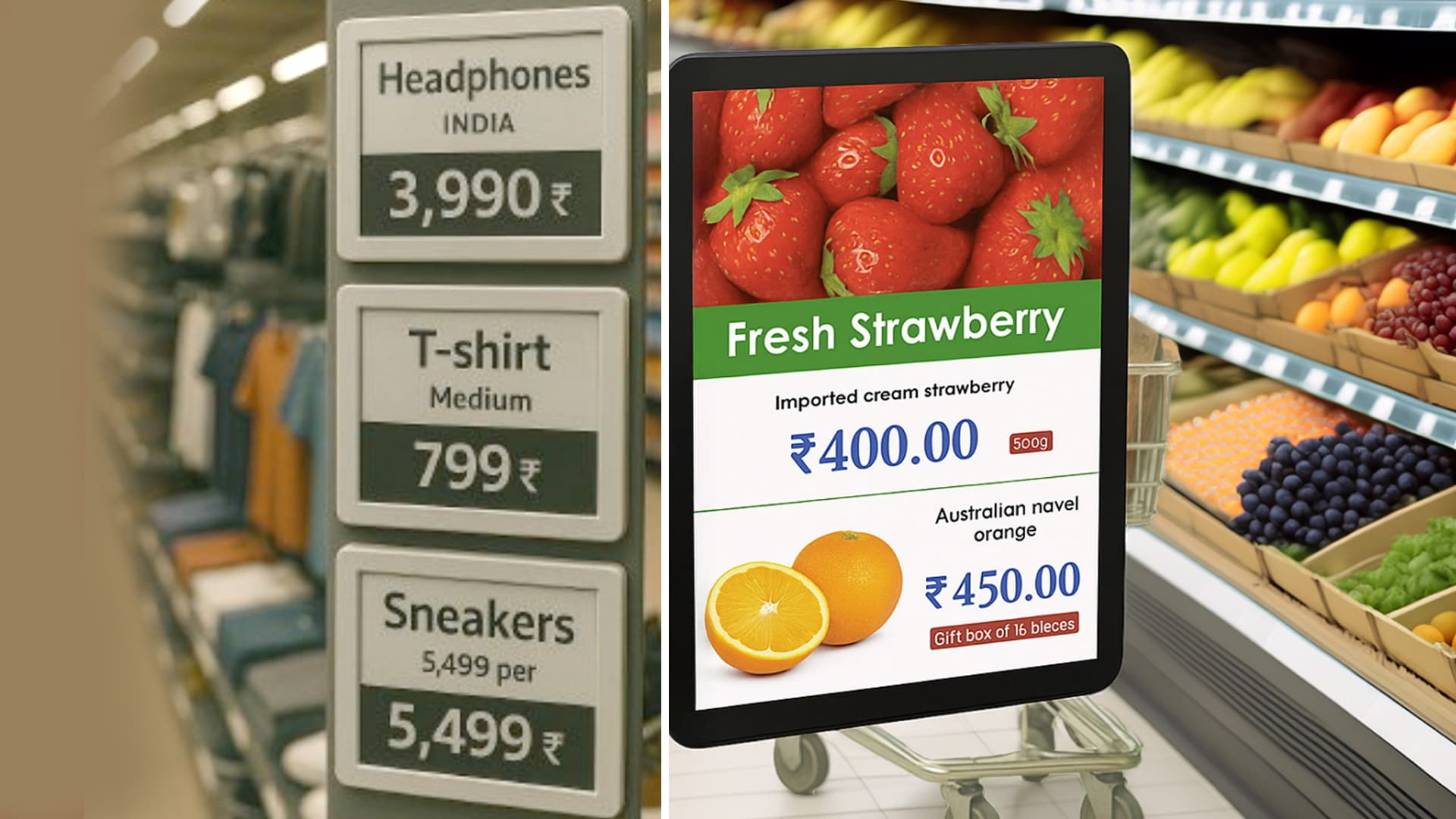The audiovisual landscape in retail is experiencing a quiet revolution, While the industry has long focused on high-impact LED walls, dynamic digital signage, and interactive displays, a new player is emerging that challenges traditional AV thinking, electronic paper or ePaper displays. Far from being a simple replacement for static signage, ePaper technology is reshaping how retailers approach visual communication, operational efficiency, and customer engagement.
ePaper or Electronic paper displays operate on fundamentally different principles than conventional AV solutions. Rather than emitting light, ePaper reflects ambient illumination, creating a paper-like visual experience that’s easy on the eyes and highly readable in various lighting conditions. This bistable technology only consumes power when changing content, making it exceptionally energy-efficient compared to traditional backlit displays.
For AV professionals, this represents a paradigm shift. Where conventional digital displays require constant power and active cooling, ePaper solutions can operate for months or even years on minimal power sources. This ultra-low power consumption opens installation possibilities in locations where traditional AV infrastructure would be impractical or cost-prohibitive.
Electronic Shelf Labels – ESL
The most widespread application of ePaper in retail is Electronic Shelf Labels (ESLs), which are revolutionizing price communication and inventory management. These small displays, typically ranging from 1.5 to 7 inches, connect wirelessly to central management systems, enabling real-time price updates across entire store networks.
From an AV perspective, ESLs represent a massive distributed display network that operates seamlessly in the background. Unlike traditional price tags that require manual updates, ESLs can synchronize pricing changes across thousands of locations simultaneously. This capability is particularly valuable for retailers managing dynamic pricing strategies, flash sales, or inventory clearance events.
The deployment scale is impressive. Major leading international retailers have equipped their entire store networks with ePaper ESLs, creating distributed AV networks that span hundreds of locations. This scale of deployment demonstrates the technology’s reliability and the confidence retailers have in ePaper as a long-term AV solution.
Beyond Pricing
While ESLs dominate current ePaper implementations, the technology’s AV applications extend far beyond shelf pricing. Large-format ePaper displays are increasingly deployed for wayfinding, promotional messaging, and information displays throughout retail environments.
These installations offer unique advantages for AV integrators. ePaper displays can be mounted in challenging locations—such as freezer doors, outdoor kiosks, or areas with limited power access—without the infrastructure requirements of traditional digital signage. Their thin profile and flexible mounting options provide design freedom that conventional displays cannot match.
In shopping centers and transit retail environments, large ePaper installations serve as dynamic information hubs, displaying schedules, directions, and announcements while maintaining readability in bright ambient conditions. The displays’ ability to retain content during power outages ensures continuity of critical information, a reliability factor that traditional AV solutions cannot provide.
Integration Challenges and Opportunities
For AV professionals, ePaper integration presents both opportunities and considerations. The technology requires different expertise than traditional display systems, particularly in wireless communication protocols and power management. However, this creates a competitive advantage for integrators who master ePaper deployment and management.
The integration process involves establishing robust wireless networks capable of supporting hundreds or thousands of ePaper displays simultaneously. Unlike traditional AV networks that handle high-bandwidth video content, ePaper networks prioritize reliability and low-latency communication for frequent, small data updates.
Content management systems for ePaper also differ significantly from conventional digital signage platforms. The focus shifts from video processing and playback to template-based content generation, real-time data integration, and synchronized mass updates across distributed networks.
The Sustainability Imperative
Environmental considerations are driving significant changes in retail AV specifications, and ePaper technology aligns perfectly with sustainability goals. The dramatic reduction in power consumption compared to traditional displays translates directly to lower operational costs and reduced carbon footprint.
For retailers operating thousands of displays across multiple locations, the energy savings compound significantly. A typical ePaper ESL consumes less than 1% of the power required by an equivalent LCD display, making the technology attractive both economically and environmentally.
The elimination of printed materials represents another sustainability benefit. Traditional retail environments generate substantial paper waste through frequent price tag updates, promotional materials, and signage changes. ePaper displays address this waste stream while providing greater flexibility and responsiveness than printed alternatives.
Data Integration and Smart Retail
Modern ePaper systems are evolving beyond simple display functionality to become data collection and analysis platforms. Advanced ESLs incorporate sensors that monitor customer interaction, product movement, and environmental conditions. This sensor integration transforms ePaper displays from passive information devices into active components of smart retail ecosystems.
The data collected by ePaper systems provides valuable insights for retailers and creates new opportunities for AV professionals. Integration with analytics platforms, customer relationship management systems, and artificial intelligence engines enables personalized content delivery and dynamic pricing strategies.
This intelligence capability positions ePaper as a crucial component in the Internet of Things (IoT) retail environment, where displays, sensors, and data systems work together to create responsive, adaptive retail spaces.
Future Developments and Market Potential
The ePaper market is rapidly evolving, with new form factors, improved refresh rates, and enhanced connectivity options expanding application possibilities. Color ePaper displays are becoming more prevalent, offering greater visual impact while maintaining the technology’s core efficiency advantages.
For AV professionals, the ePaper market represents significant growth potential. As retailers increasingly prioritize operational efficiency, sustainability, and customer experience, ePaper solutions address all three priorities simultaneously. The technology’s scalability makes it suitable for everything from small boutiques to large retail chains.
The integration of ePaper with existing AV infrastructure creates opportunities for comprehensive retail communication systems. Hybrid approaches combining ePaper for static or semi-static content with traditional displays for dynamic video content optimize both impact and efficiency.
Strategic Considerations for AV Professionals
The rise of ePaper technology requires AV professionals to expand their expertise and service offerings. Understanding wireless communication protocols, power management, and content management systems specific to ePaper becomes essential for comprehensive retail AV solutions.
The technology’s reliability and low maintenance requirements change the traditional AV service model, shifting focus from reactive maintenance to proactive system optimization and content strategy support.
Conclusion
ePaper displays represent more than just another display technology—they’re reshaping the retail AV landscape by prioritizing efficiency, sustainability, and intelligent integration over pure visual impact. For AV professionals, ePaper offers new opportunities to deliver comprehensive, scalable solutions that address the evolving needs of modern retail environments.
As the technology continues to mature and expand, ePaper will likely become a standard component in retail AV specifications, working alongside traditional displays to create more efficient, responsive, and sustainable retail communications systems. The quiet revolution has begun, and forward-thinking AV professionals are already positioning themselves to lead this transformation.




